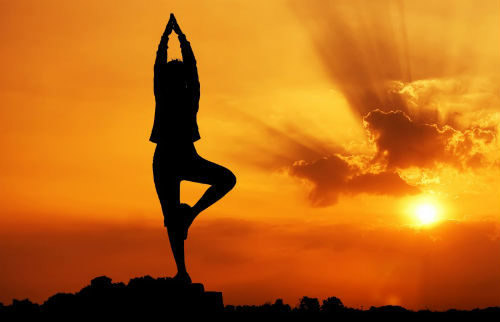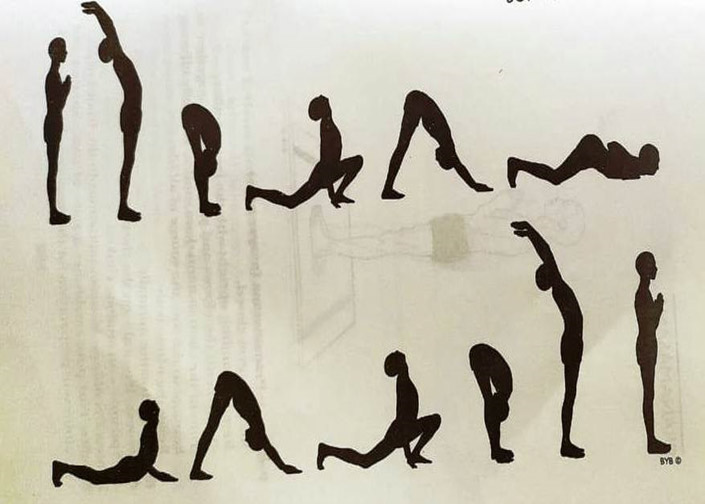
SALUTATIONS TO THE SUN
Surya Namaskara is a Vedic concept of holistic well-being discovered by the enlightened sages millennia ago. It is a group of twelve Asanas (six postures with two repetitions for both the sides of body) that are practiced while uttering a corresponding set of twelve mantras in adoration to the Sun along with inherent breath control (prANAyAma) and mental focus (dhAraNA). An ideal combo of physical, mental and spiritual exercises to start morning practice. The Sun, being a visible God, is called Surya and namaskara means ‘salutations’ in Sanskrit. It is considered to be a complete sadhana.
The Sun symbolises spiritual consciousness in the Vedas and as many as ten Suktas in the RgVeda are dedicated to the Sun. Several hymns are scattered in adoration of the Sun and his various attributes in the Vedas. The Gayatri mantra being a well-known example. In the later Vedic texts and the Puranas the 12 forms of the Sun are recognized as twelve months of the year. However, the list of the epithets and names of Sun is exhaustive. Out of these, 12 names have been selected for Surya namaskara. They are:
Mitra- Sun, the Mate
Ravi- Sun, the Protector
Surya- the Sun God
Bhanu- the luminous Sun
Khaga- the Sun moving around the celestial sphere
Pushana-Sun, the Nourisher
Hiranyagarbha-Sun, the ultimate source of Energy
Marichin- the Sun with rays
Aditya- the Sun, brought forth by the un-decaying Mother nature
savitR-Sun, the impeller of action
Arka-Sun, the brilliant one
Bhaskara-Sun, the illuminator
Since the Vedic times, the Sun is worshipped by Hindus on a daily basis. In the system of yoga, the sun is represented by pingala or surya nadi, the channel carrying the force of life. Surya namaskara has a direct vitalising effect on the physical body and mental consciousness. The Yogis developed this dynamic group of twelve asanas with a definite pattern of body form, breathing energy and mental rhythm. The asanas are an effective way of loosening up, stretching, massaging and toning of all the joints, muscles and internal organs of the body as also inducing an expansion of awareness.
Time and Space:Take bath before the practice. The ideal time to practice Surya Namaskara is at sunrise, preferably in the open air, facing the rising sun or North. Sunset is also good time to practice as it stimulates the digestive fire. Surya namaskara, however, may be practiced at any time provided the stomach is empty.
Preparation: Stand with the feet together or slightly apart, and the arms hanging loosely by the side of the body. Close the eyes gently and become aware of the whole physical body as one homogeneous unit. Balance the body weight equally on both feet. Be aware of yourself and experience the vital force surging up from the contact point of soles and the ground. Now take the awareness to the eyebrow centre and visualise a brilliant, red rising sun infusing the whole body and mind with its vitalising and healing rays.
Position I: Pranamasana (Prayer Pose) Mantra: Om Mitraya Namaha
Keep the eyes closed.
Remain standing upright with the feet together.
Slowly bend the elbows and place the palms together in front of the chest in namaskar mudra, mentally offering homage to the sun, the source of all life.
Relax the whole body.
Breathing: Breathe normally. Awareness: on the chest area.
Position 2: Hasta Utthanasana (Raised Arms Pose) Mantra: Om Ravaye Namaha
Raise and stretch both arms above the head.
Keep the arms separated, shoulder width apart.
Bend the head, arms and upper trunk backward.
Breathing: Inhale while raising the arms. Awareness: on the stretch of the abdomen and expansion of the lungs.
Position 3: Padahastasana (Hand to Foot Pose) Mantra: Om Suryaya Namah
Bend forward until the fingers or palms of the hands touch the floor on either side of the feet.
Try to touch the knees with the forehead.
Do not strain.
Keep the knees straight.
Breathing: Exhale while bending forward with maximum contraction of the abdomen in the final position; Awareness: on the pelvic region
Position 4: Ashwa Sanchalanasana (Equestrian Pose) Mantra: Om Bhanave Namaha
Place the palms of the hands flat on the floor beside the feet.
Stretch the right leg back as far as possible.
At the same time, bend the left knee, keeping the left foot on the floor in the same position. Keep the arms straight In the final position, the weight of the body should be supported on both hands, the left foot, right knee and toes of the right foot. The head should be tilted backward, the back arched and the inner gaze directed upward to the eyebrow centre.
Breathing: Inhale while stretching the right leg back.
Awareness: on the stretch or between the eyebrows
Position 5: Parvatasana (Mountain Pose) Mantra: Om Khagaya Namaha
Take the left foot back beside the right foot.
Simultaneously, raise the buttock and lower between the arms, so that the back and legs form two sides of a triangle.
The legs and arms should be straight in the final position.
Try to keep the heels on the floor in the final pose and brig the head towards the knees.
Do not strain.
Breathing: Exhale while taking the left leg back.
Awareness: on relaxing the hips or on the throat.
Position 6: Ashtanga Namaskara (Salute With Eight Parts) Mantra: Om Pushne Namaha
Lower the knees, chest and chin to the floor. In the final position only the toes, knees, chest, hands and chin touch the floor. The knees, chest and chin should touch the floor simultaneously. If this is not possible, first lower the knees, then the chest, and finally the chin. The buttocks, hips and abdomen should be raised.
Breathing: The breath is held outside; no respiration. Awareness: on the abdomen
Position 7: Bhujangasana (Cobra Pose) Mantra: Om Hiranya Garbhaya Namaha
Lower the buttocks and hips to the floor,
Straightening the elbows, arch the back and push the chest forward into the cobra pose. Bend the head back and direct the gaze upward to the eyebrow centre.
The thighs and hips remain on the floor and the arms support the trunk.
Unless the spine is very flexible the arms will remain slightly bent.
Breathing: Inhale while raising the torso and arching the back.
Awareness: on relaxation of the spine.
Position 8: Parvatasana (Mountain Pose) Mantra: Om Manichaye Namaha
This stage is a repeat of position 5.
From bhujangasana assume parvatasana
The hands and feet do not move from position 7.
Raise the buttocks and lower the heels to the floor
Breathing Exhale while raising the buttocks
Awareness: on relaxing the hips or on the throat region.
Position 9: Ashwa Sanchalanasana (equestrian pose) Mantra: Om Adityaya Namaha
This stage is the same as position 4.
Keep the palms flat on the floor.
Bend the left leg and bring the left foot forward between the hands. Simultaneously, lower the right knee so that it touches the floor and push the pelvis forward.
Tilt the head backward, arch the back and gaze at the eyebrow centre.
Breathing: Inhale while assuming the pose.
Awareness:-on the stretch from the thigh to the chest, or between the eyebrows
Position 10: Padahastasana (hand to foot pose) Mantra: Om Savitre Namaha
This position is a repeat of position 3.
Bring the right foot forward next to the left toot.
Straighten both knees.
Bring the forehead as close to the knees as possible without straining
Breathing: Exhale while performing the movement.
Awareness: Physical-on the pelvic region.
Position 11: Hasta Utthanasana (raised arms pose) Mantra: Om Arkaya Namaha
This stage is a repeat of position 2.
Raise the torso and stretch the arms above the head.
Keep the arms separated, shoulder width apart.
Bend the head, arms and upper trunk backward.
Breathing: Inhale while straightening the body.
Awareness: Physical – on the stretch of the abdomen and expansion of
Position 12: Pranamasana (prayer pose) Mantra: Om Bhaskaraya Namaha
This is the final position and is the same as position 1.
Bring the palms together in front of the chest.
Breathing: Exhale while assuming the final position.
Awareness: Physical – on the region of the heart.
VIDEOS :
Please watch videos in slow motion, match with the steps of the text and memorize the final pose as given in the sketch below:

Credits: Bihar School of Yoga, Mungerand SSB Yoga team

Really all thing is very important to know everyone thank you Sir.
thank you